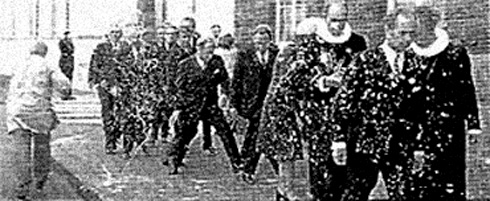"THE MUSIC VIDEO IS HERE TO STAY"
Whether an art form in its own right or just a too costly commercial, the music video has today lost its pivotal status as a major marketing tool in the music business. The 80s heydays initiated by MTV, the world’s first music video channel launched in 1981, are far behind and the best treasured music videos of today are often well hidden somewhere deep inside the YouTube jungle. At the same time, MTV is too busy trying to come up with a new twist on the same “horny kids living together in a tight dwelling” reality program to bother.
Just as in the case of the first music video shown on MTV on August 1, 1981, Video Killed The Radio Star by the Buggles, the first music video made in Iceland, Myndbandið by Sonus Futurae, was a statement in itself, one that spoke of a new era in music and technology.
Made up of three guys still in their teens, Sonus Futurae was one of Iceland’s very first synth-pop bands. Not only was the name of the band meant to sound futuristic but the title and the lyrics to the video’s song also sounded prophetic, almost like a manifesto for a new era. Simply titled Myndbandið (“The Music Video”) the song’s chorus stated that “the music video has taken over” and hinted at that the band or rather its novelty synth-pop or maybe just the invention of the music video was nothing less than a revolution on a par with the advent of microcomputers (“Merkilegt hvað margir halda að band þetta sé bölvaldur/skiljiði ekki að byltingin er bylting á við örtölvur?”).
The National Broadcasting Company of Iceland (RÚV) had since its televised inauguration in 1966 hosted various programs that included studio performances by some of Iceland’s most prominent bands, and had since the late 70s aired a weekly music program called Skonrokk, dedicated to the latest and the most stylish music videos from the UK and the US. Sonus Futurae’s Myndbandið became the first “independently made” music video—made outside the studios and without the equipment of RÚV—to be aired on the show. Jón Gústafsson, one of the three members of the band, actually became a presenter of teenage music shows at RÚV in the 80s before making a career as a filmmaker. Jón recalls how their publisher and former singer with hippie band Flowers became a key figure in the making of the video:
“Our publisher, Jónas R. Jónasson, had just moved from LA and didn’t think it was much of a deal to make a proper music video. He rented the best equipment on the market for us (U-matic low-band) and directed the video himself. RÚV wouldn’t broadcast the video and one of the reasons they gave was technical—that our U-matic low band was below their standards. Jónas wouldn’t budge and refused to leave the premises of RÚV until they accepted the video.”
 The music video was aired on the aforementioned music program Skonrokk on December 3, 1982. In the same month, Sonus Futurae released their debut album, Þeir sletta skyrinu sem eiga það (“Those cast the skyr that have it”—both the cover and the title a certain homage to Helgi Hóseasson, Iceland’s most famous protestor). Another reason RÚV gave for their reluctance to air an Icelandic video made outside their premises was the apparent “danger” that it would give a bad example and result in a flood of independently made music videos all demanding to be aired at once. Those worries were obviously well founded, since only three years later the amount of Icelandic videos was such that the country’s most beloved and prolific band, Stuðmenn, made seven music videos in the year 1985 alone, to name an example.
The music video was aired on the aforementioned music program Skonrokk on December 3, 1982. In the same month, Sonus Futurae released their debut album, Þeir sletta skyrinu sem eiga það (“Those cast the skyr that have it”—both the cover and the title a certain homage to Helgi Hóseasson, Iceland’s most famous protestor). Another reason RÚV gave for their reluctance to air an Icelandic video made outside their premises was the apparent “danger” that it would give a bad example and result in a flood of independently made music videos all demanding to be aired at once. Those worries were obviously well founded, since only three years later the amount of Icelandic videos was such that the country’s most beloved and prolific band, Stuðmenn, made seven music videos in the year 1985 alone, to name an example.
While Sonus Futurae’s Myndbandið is even more lost in the dim dungeon of RÚV’s archives than it is in YouTube’s jungle, most of those videos made by Stuðmenn in 1985 can be viewed on YouTube. Our recommendation has to be this “camel-pop” track with its accompanied mashup of a kitschy/po-mo blue-screened video that cites with just as much liberty the pop-art of Erró as it does haphazardly selected oriental imagery only few months before Stuðmenn became only the second Western pop-band (after WHAM! made it big) to play China.
Buy subscriptions, t-shirts and more from our shop right here!

















